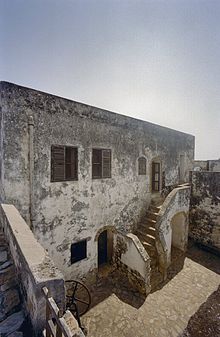Fort Patience
Fort Patience , historically correct Vestung de la Patience , later also called Fort Lijdzaamheid or Fort Leydsamheid in Dutch ( German for "the fort of patience" ), is a fortress from the 17th / 18th century. Century in the place Apam on the coast of Ghana .
The Dutch built Fort Lijdzaamheid at the request of a local ruler who was threatened by powerful neighbors allied with the British. The name "Vestung de la patience" is due to the long construction period of the fortress, that is, originally more of a single stone house, which covered the period from 1697 to 1702. It is a reminder of the patience that was shown in the construction of the fortress due to the constant quarrels that were broken off by some anti-European chiefs in the neighborhood. The land belonged to the King of Acron at the time the fort was built and was under the general patronage of the Fanti Confederation at the end of the 17th century . In 1704 the house was fortified and equipped with eight cannons. The British conquered the fortress in 1782, and the Dutch took it again three years later.
The city of Apam was captured, plundered and largely destroyed by the Ashanti on March 1, 1811 as part of the Fanti Ashanti War . The then Dutch fort was spared by the Ashanti. About a week after the Ashanti retreated , an Akimi army led by Okyenhene (King of Akim-Abuakwa) Atta Wusu Yiakosan occupied the city with the aim of cutting off the retreat of part of the Ashanti army that operated in nearby coastal areas. Since the Dutch were generally considered allies of the Ashanti, Atta stormed the fort. It was extensively looted and largely destroyed, that is, the walls were partially torn down and all the gun mounts smashed or made unusable. The Compagnie slaves previously in the fort escaped to Fort Beraku (Berracoe), which was also in Dutch possession at the time. The alleged reason for this act of violence by the Akimer was, so it was subsequently alleged, that the Dutch sergeant in charge of the command did not want to reveal to the Akimer king the route of retreat that the Ashantine army had taken on their departure.
Some time later, the Dutch rebuilt the fort. In 1868 the fortress became British as part of the great exchange of bases on what was then the Gold Coast between the Dutch and the British.
The fortress was used in modern times as a police station and also as a post office, today a guest house is operated there.
See also
Web links and sources
- Henry Meredith: An Account of the Gold Coast of Africa. With a brief history of the African Company . Printed for Longman, Hurst, Rees, Orme, and Brown, London 1812 (Reprint: Cass, London 1967 ( Cass library of African studies. Travels and narratives 20, ZDB -ID 413575-1 )).
- nationalarchief (English with many photos)
- Tradecastles and Forts of West Africa, W. Lawrence
Coordinates: 5 ° 17 ′ 36.09 " N , 0 ° 44 ′ 32.15" W.



